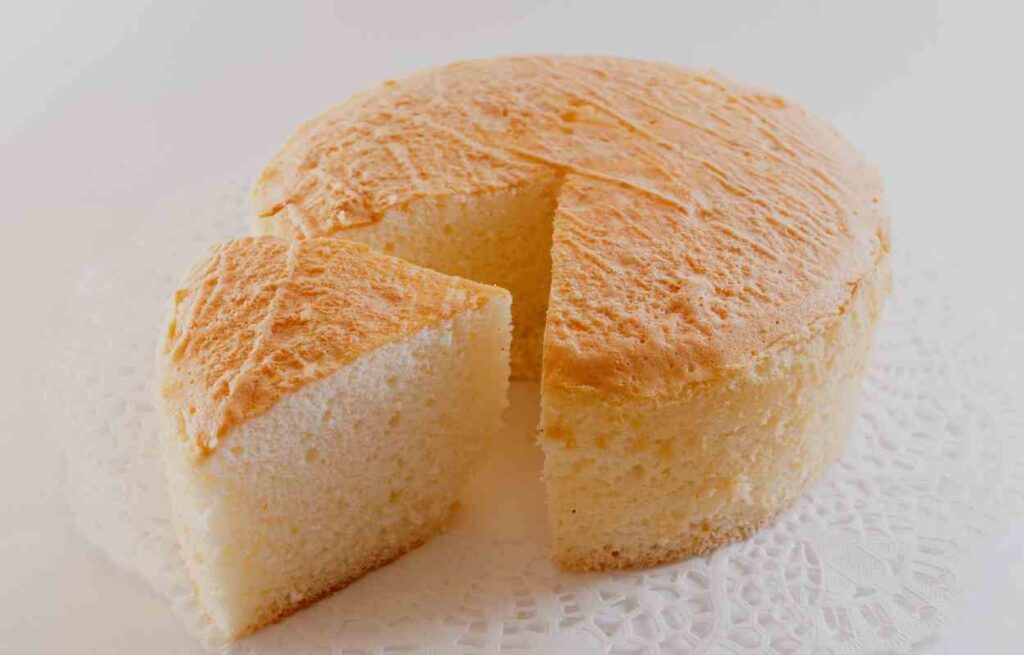Why Is My Sponge Cake Sticky?
Sponge cakes are delectable pastries formed from flour and water, or sponge, that is typically served as a dessert dish. Lemon sponge cake and chocolate sponge cake, for example, can be created with both citrus and chocolate flavor.
Why Is My Sponge Cake Sticky? A sponge cake can become sticky due to various factors. Excessive butter leads to a greasy texture and crispy edges. Prematurely covering or wrapping the cake traps moisture, causing stickiness. Overcooking results in dry and hard edges, while outdated baking powder makes the cake dense and crusty.
Additionally, a sugar-water reaction can contribute to stickiness. To address this, using room-temperature butter and adjusting baking techniques can prevent a hard crust. Trimming off crusty edges can salvage the cake’s texture.

Why Is My Sponge Cake Sticky After Baking?
If you prepare a sponge cake every now and again and discover that it remains sticky after baking, there are various possible causes.
- The sponge may not have risen properly, resulting in an under-risen sponge.
- It could also be owing to the incorrect proportion of wet and dry materials.
- Too much flour or egg can result in a dry sponge.
- Furthermore, if your sponge does not rise properly, you may have used too much sugar or a raising agent.
- Your oven’s temperature is incorrect, and some baking time modifications are required.
- Too much butter or oil in the cake tin causes a greasy cake. Too much butter or fat cooked the sponge, making the surface smooth and crispy.
- A cracked sponge cake is not a good omen. Cracked cakes can be repaired with jam or ganache. Checking the baking temperature, rising agent, or tin can help prevent splits in a sponge.
How to Fix a Sticky Cake Top?
Cracking on the top of your cake indicates that it is not fully cooked. It could have risen too quickly, or the cake tin could have been too tiny. If this happens, there are some simple things you may do to save your cake.
Make sure the container is large enough to hold the sponge without allowing it to spread. If you don’t fill the tin three-quarters full, it’ll be gone. Then, combine it according to the directions, making sure there are no obvious cracks.
One of the causes of a sticky sponge cake top is overmixing. It will cause the sponge to lose air, which is necessary for a light, fluffy texture.
It is critical to ensure that the flour is uniform. The cake should be substantial but not overly thick. If the cake is wrapped or covered before it has entirely cooled, it will get sticky.
To avoid this, let the cake cool fully on a wire rack.
How Do You Prevent a Sponge Cake from Sinking?
You may prevent a sponge cake from sinking by following the recipe’s directions, as too much leavening can generate a sinkhole. To keep your cake from sinking, use an oven thermometer and a kitchen timer. When baking, the size of the pan is very important.
It’s likely that your sponge cake recipe does not call for a pan. Overmixing the batter can result in a sinkhole. Bubbles can expand if there is too much leavening. It’s a good idea to use one and a quarter teaspoons of baking soda.
A sponge cake sinking during baking can be caused by a number of circumstances. The primary cause could be incorrect ingredient mixing or an overheated oven. If you believe you have overmixed the sponge cake dough, you may be suitable.
If you’re making a meringue sponge, you’ve most likely over-mixed the dough and allowed it to absorb too much moisture.
Another reason that can cause your cake to sink is a lack of thorough baking. Your oven should be set to at least 100 degrees Celsius (212 degrees Fahrenheit).
It should take at least 30 minutes before it starts to sink. If it doesn’t, let the cake cool for 30 minutes before attempting to move it. Once the cake has cooled, remove it from the tin using a knife. If you can’t remove it by hand, cover it with greaseproof paper to keep it from adhering.
What Is the Best Way to Frost a Sticky Cake?
A Sticky Cake may struggle to get a decent icing job. If you want a smooth, even finish on your cake, start with a pressed texture. You can also slide an offset spatula under the cake. Before you begin frosting the cake, it should be thoroughly cold. This will prevent the icing from sticking to the cake. Here’s a quick guide to get the best outcomes.
To begin, prepare your cake by applying a crumb coat. This is a thin layer of icing that keeps crumbs in place. Begin with half a cup of frosting and thin it with water or milk.
Spread the frosting outwards from the center with an offset spatula. Before adding the next layer, smooth out any ridges in the cake. Then, with the remaining half cup of frosting, repeat the process.
Place a dollop of frosting on the cake stand or plate first. Spread the icing evenly on the cake with an offset spatula. Spread the frosting on the sides of the cake using the overhang.
To protect the surface of the cake, wrap it in wax paper or parchment paper. When you’re finished, you’re ready to decorate. Crumbs can also be used as decoration.
Why Is the Top of My Cake Sticky After Baking?
If you use an expired leavener, the sponge cake will have a sticky and rubbery surface. The expiry date prevents the chemical process that causes air bubbles. You may wind up with a dense, gummy, or flat cake, and baking at the incorrect temperature may result in an under-risen cake. To avoid this problem, set the oven to a high temperature.
Under-mixing is another major cause of this issue. To incorporate a lot of air, make sure the batter is fully blended. Too much flour or too little baking powder will result in a dense and heavy sponge.
Use the appropriate amount of butter. Use a smaller size of butter if it’s too much. Finally, carefully measure out the dry ingredients and mix them together until thoroughly combined.
Overheating the batter might also result in an oily cake. You may have over-beaten the batter, causing it to become too soft. A moist cake will remain moist. You might also use a thermometer.
The temperature of your oven is critical for baking a cake that is neither dry nor overly moist. If the top of your cake is stuck to the tin, let it for half an hour before removing it.
Why did my baked sponge cake deflate?
Sponge cakes frequently deflate after baking for a variety of reasons. Here are a handful of the most typical causes.
The first reason is that sponge cakes contain a lot of air, making them more prone to deflation than other forms of cakes.
The sponge cake instantly pulls away from the sides of the tin after being removed from the oven.
Furthermore, sponge cakes deflate during baking because oven heat drains through the cake and into the pan. Furthermore, if the oven door is left open, air can escape through the cake.
An incorrect baking temperature is a secondary cause. Overheating ovens cause the sponge to deflate, so adjust your oven temperature accordingly.
It is also critical to provide adequate time for the cake to cool in the pan. After it has cooled, run a knife down the sides of the cake to release it from the tin.
If it’s stuck to the pan, slide it onto a cooling rack or your palm to free it. Cover the bottom of the tin with greaseproof paper to prevent it from sticking to the pan.
Conclusion
If your cake is really sticky, you can try to remedy it by using room-temperature butter in the recipe. Alternatively, you can try to dry the cake out by placing it on a wire rack in the oven for a few minutes.
You can prevent the cake from sinking if you follow the recipe’s directions. To keep your cake from sinking, set a kitchen timer and use an oven thermometer.
